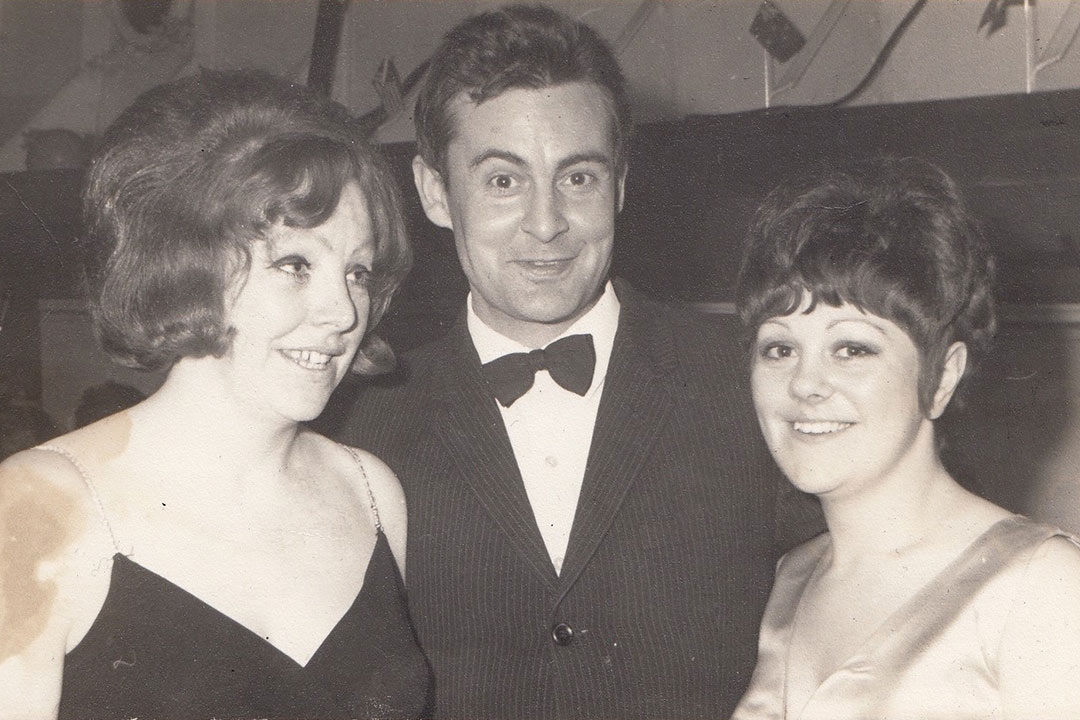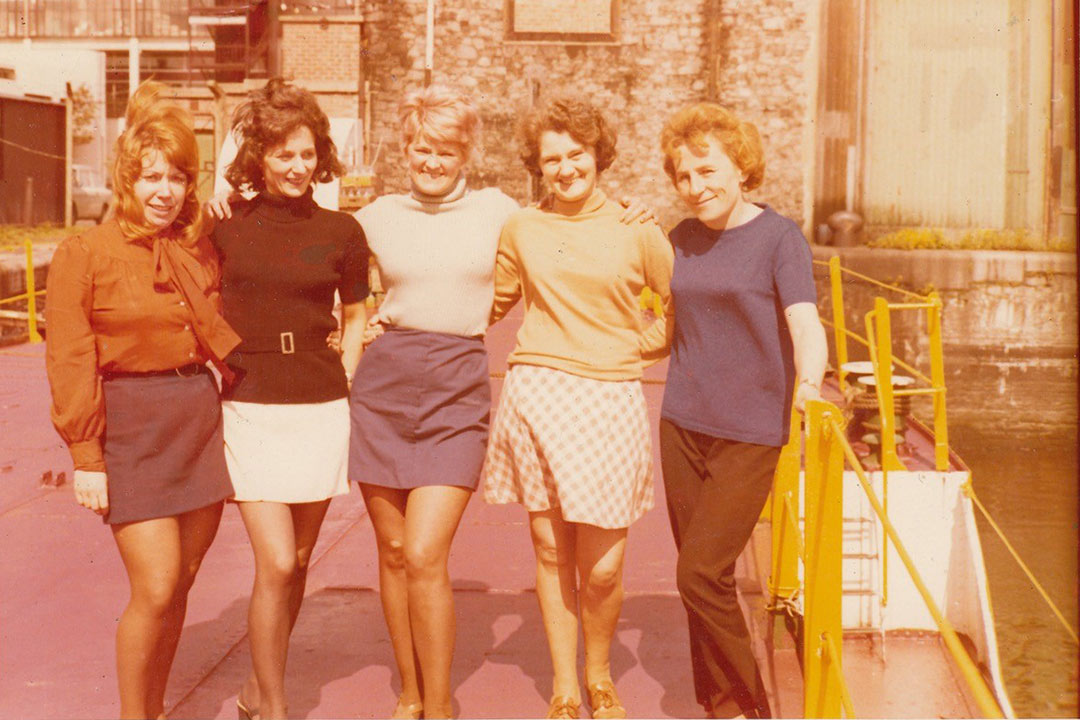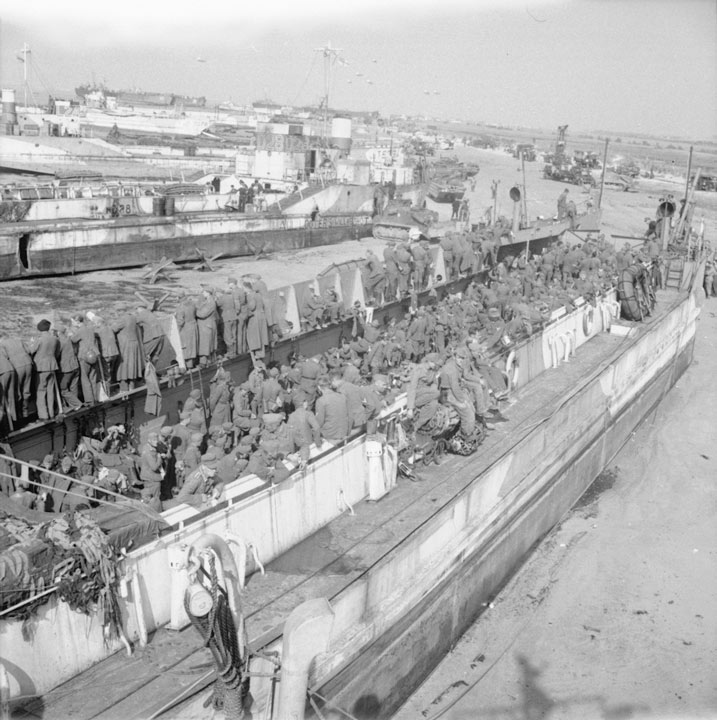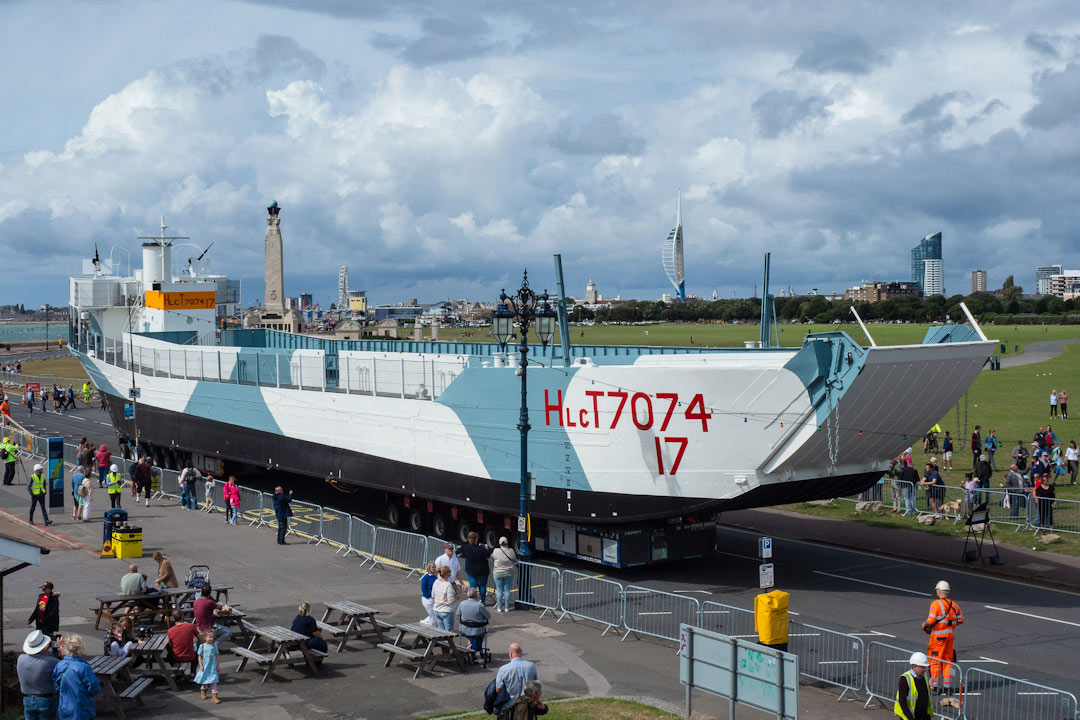Clubship Landfall
Landing Craft Tank 7074 (LCT 7074) is the only known surviving ship of its kind which took part in the D-Day landings on 6 June 1944. It has undergone extensive conservation and restoration work ready to go on display at The D-Day Story in Portsmouth. Here Freja Evans-Swogger shares her memories of an unexpected part of the ship's history in Liverpool.

Landfall with the Liver Building in the background © The Evans Family Archive
When somebody asks “What do you think of when I say 1970s?”, what are your first thoughts? Glam rock? Space hoppers? Power cuts? For me, it’s axle grease, stale bitter and the grimy Dock Road with the sound of gulls and lapping water. Our Dad, George Evans, owned The Landfall, a floating nightclub, and my childhood Saturdays were spent treating the ship like my own personal playground.

George Evans with two unknown glamorous ladies © The Evans Family Archive
Saturdays at the docks
The Landfall (otherwise known as LCT7074, now the only surviving Second World War Tank Landing Craft of its type) was a huge, hulking great thing. She sat low in the water of various mooring-points along the Dock Road, which in the 1970s was a grim, rather forlorn and rough part of town – not the shiny, bustling tourist honeypot it is today.
Every Saturday we all used to bundle into the car and travel from our home in Halewood to the Albert Dock, which was then a windy, broken glass-filled ruin forbidden to us kids, and The Landfall, moored in Salthouse Dock. Unlike the fashionable experience of the nighttime clubbers, Landfall showed us the distinctly less glamorous daytime aftermath - what you see as the sun come up and the empties are cleared away...
Exploring the ship
I felt completely at home having the full run of the ship, her gangways, storerooms, the depths below and the deck above. I was terrified of being caught in the (to me at least) huge, sharp edged and heavy steel door onto the deck at the stern, where the remains of her wartime winches, other mysterious pulleys and chains were still set up – but I wasn’t bothered at all by the much bigger risk of falling overboard.
Instead I have one of those odd, almost physical, whole-body memories of the clank of my shoes as I ran all over the steel decking, painted with endless layers of gloss paint that reflected the hot sunshine. I popped up through hatches, climbed ladders, and ran along the sides of the ship, protected from falling overboard only by a single, slim wire railing. Leaning out over the side, you could see dirty, oil-slicked and soupy-looking water slopping lazily against the ship’s stubbornly practical metal sides. Sometimes you would be lucky to catch sight of a bloom of jellyfish amongst the bottle tops and corks, which were evidence of the previous night’s mysterious goings-on.
Below decks, I’d reluctantly sit in the glamorous Lounge, with a glass-panelled light-up dance floor (so stylish!) and alcoves filled with large circular tables, topped with thousands of Victorian copper pennies that I eventually gave up trying to peel off. Behind the bar, where we were not usually allowed to go, was a broken windscreen-glass and coloured perspex map of the world – trying, perhaps unsuccessfully, to hint at the glamour of maritime travel.

Landfall staff looking very fashionable © The Evans Family Archive
Fine dining
The Landfall thought of itself as providing a rather fancy dining experience, and the menus we have in the family archive proudly boast of prawn cocktails, gammon with pineapple rings, and (I remember discovering with horror) the ultimate in 1970s sophistication: mushroom vol au vents. There was a particular type of rock-hard, crusty dinner roll particular to the time that I especially remember, served with what was billed as special ‘cream of asparagus soup’ - however, behind the scenes, in the greasy Galley kitchens, the reality was somewhat less glamorous – the ‘special’ soup came straight from a huge catering tin of asparagus soup powder. I also recall one particular weekend when Dad had a big event on, and we were press-ganged into helping him prepare food. My job was to paint melted catering margarine from a huge tub, onto slices of white bread with a paintbrush. Posh food indeed.
Fond memories of a wartime survivor
Despite the somewhat grimy reality behind the facade of glamour, I loved the ship, and didn’t recognise the reality of what must have been quite a hard place to run. And I’m sure the novelty wore off for my Dad – especially after the Landfall had to move from the silted-up and derelict Albert Dock area to a dock further north along the road, to Collingwood Dock, which had an even worse reputation. I certainly remember him coming home with a black eye and broken ribs he said he sustained when some rowdy sailors threw him down the stairs.
Of course, this was all rather mysterious to me, with child’s eye view of the daytime ship, and no knowledge of the grown-up world of Liverpool nightlife, and even more remote was any idea of Landfall’s previous life, only twenty years earlier, on D-Day and the horrors of Gold Beach.

LCT 7074 (foreground) and other LCTs on Gold Beach on 7 June 1944.
LCT 7074 had landed its tanks and has German prisoners of war on board, who were then later off-loaded. © IWM
To me, she was just a funny old place of clanging metal decks, oily dock water, stale bread rolls and sticky, beery carpets. She was a kid’s dream playground, and in a strange way, I hope my small childlike pleasures of sunshine and running around helped to balance out some of the awfulness of her wartime beginnings. To most who see her now, she’s a wartime survivor, a relic of brutal conflict, but to me, when I remember her, I’ll always think of sunshine on old metal - and a much-loved childhood friend.
Further information
Find out more about Landfall’s history on the D-Day Landings website.
Tyne & Wear Archives and Museums have published the following blogs about LCT 7074:

LCT 7074 being moved along the Portsmouth waterfront to its new location at The D-Day Story museum
© The D-Day Story, Portsmouth
